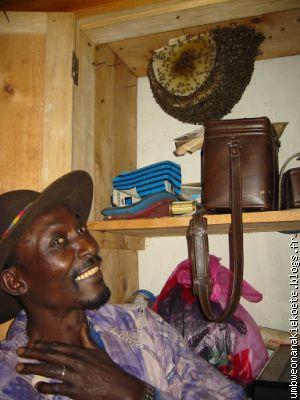umbweonanakiecote
Beekeeping: A colony if Stingless Bees at the centre


Picture: Inside the hive of a Trigona colony
The stingless bees are of Trigona and Meliponula species and their honey is highly prized and well sought after for medicinal use.
There are about 20 000 species of bees known all over the world, but of these only about 500 are `social' bees; all the rest are solitary - they do not form colonies and the females work alone. Excluding the subsocial bees and the bumble bees (which do not occur in Africa south of the Sahara), all social bees are placed in the family Apidae, and in Africa these include the well-known honey bees and the little stingless bees.
The stingless bees, also known as "mopane bees"or "mocca bees", belong to the genus Trigona. They are tiny; indeed some of them, at only about 3 mm long, are among the smallest of all bees. They donnot sting because their stings are vestigial and useless as weapons of defence; so instead they swarm out of their nest if disturbed and buzz about in front of one's face in a verv irritating way, settling in the hair and on the eyebrows and forehead, crawling into eyes, mouth and nose and generally being very unpleasant. On some occasions they bite freely. They nest in hollow tree trunks and in holes in walls or rocks. The groundnesting species also use readymade cavities, such as termite nests. An unusual nesting site of one African Trigona species is in the nest of a cocktail ant.
The nesting material, usually dark coloured, is called cerumen. It is a mixture of light wax and large amounts of resin gathered by the bees. The wax is produced between the dorsal segments of the abdomen, unlike the honey bee which produces it from the underside. The cerumen is used to block up cracks and crevices and also in the construction of the curious spout or funnel that marks the entrance to the nest. It has been suggested that the sticky funnel at the entrance prevents ants and other unwanted visitors from entering. Sentries remain on guard at the entrance during the day, as is the case with the honey bee, but at night the stingless bees close up the funnel with a temporary plug of wax and gum.
The interior of the nest of stingless bees consists of a brood section and a section for the storage of food. In the nest of Trigona gribodoi, a well-known, minute, tree-nesting species of Africa, the brood portion consists of irregular clusters of oval-shaped cells and cocoons, supported by slender pillars of cerumen. The cells, vertical and open at the top, are first filled with food and then closed after an egg has been laid erect on top of the food supply in each one. Therefore these little bees, although they are social, rear their young in very much the same way as the solitary bees do. The large storage pots, which contain pollen and honey are up to 7 mm in diameter, and made from soft cerumen, yellowish to brownish in colour.
Both the honey and the brood of stingless bees are relished by Africans. The honey is usually sourish and thin compared to that of honey bees, but it can be just as tasty, depending on the species of stingless bee and the source of the nectar. On rare occasions they may make honey from Euphorbia flowers, and since the plant is known to be poisonous, Africans regard this honey as poisonous too.
At the top the nest, which is lined with a mixture of cerumen and mud, is connected to the outside by a more or less vertical passage. Below the nest is a second passage like a pipe, half a metre or more in length and which simply ends in the ground. This acts as a drain pipe for any water that may reach the nest. Within the nest cavity the brood area is enclosed in laminated sheets of cerumen, separate from the storage pots. The brood cells are arranged in layers, to form a more or less spiral comb.
The bees make a store of sticky cerumen in the nest chamber near the entrance tunnel. This is to trap any insects that attempt to invade the nest, and puts them out of action.
Dactcylurina staudingeri is unique among the stingless bees in that it makes vertical, double-sided combs, like those of the honey bee. It is found in Central and East Africa, where it makes cerumen-covered nests under the branches of large trees. When disturbed the bees attack in large numbers, carrying lumps of very sticky cerumen which they glue onto their foe, biting at he same time. Even determined humans are soon demoralized by this treatment!
 Commentaires textes : Écrire
Commentaires textes : Écrire
| Mr. Aloys Joe Massawe |
Introduction
Welcome to Onana Apiculture Research Centre under KIEKOE-Kibosho Environment Conservation Team. This is a private initiative of Mr Aloyce Joseph Masawe, his family and in collaboration with YES-Kilimanjaro, friends from Norway. He keeps over 85 colonies of stingless African bees and sting bees around his homestead in Umbwe Onana Moshi-Tanzania. A former research technician and now retired (but not idle). Mr. Aloyce has a keen interest in all types of bees and environment at large whereby, he has developed a special hives for the stingless bees.
He would like to share his talents and interests why not his dream with all who have interest in nature at large all over the world. Since human being is not an island that he can live alone and learn from oneself, Mr, Massawe has showed a great interest to learn from different people on how to develop beekeeping on the slopes of Mount Kilimanjaro.
He has been as well open to different international groups: his neighbours, students both in and outside Tanzania, friends from different parts of the world: Norway, USA, Australia, Austria, France, Germany, Danemark, Suisse, Rwanda, Burundi, South-Africa, Kenya, Uganda etc.
The main goal of all these is to prove that together we can change the world into a lovely place to live. This goes hand in hand with taking care of the environment and all that is found in it. Above all, to maintain social relationship with everyone. Please take your time to share the little you have if not you time!
 Commentaires textes : Écrire
Commentaires textes : Écrire



